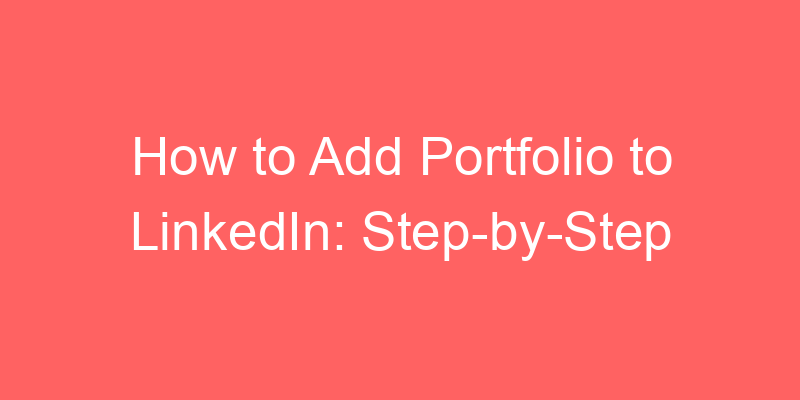How to Add Portfolio to LinkedIn
Why Should You Add a Portfolio to Your LinkedIn Profile?
Integrating a portfolio into your LinkedIn profile can significantly enhance your job search effectiveness. A well-curated portfolio not only showcases your skills and achievements but also provides tangible proof of your expertise to potential employers.
Imagine recruiters browsing through your profile and being able to see real examples of your work—whether it’s design projects, writing samples, or coding projects. This visual evidence can set you apart from other candidates and solidify your professional reputation.
How to Create and Upload Your Portfolio
Adding a portfolio to your LinkedIn profile is straightforward and can be done in a few simple steps:
- Prepare your portfolio materials. Choose a selection of your best work that highlights your skills and achievements related to your career goals.
- Convert your work into digital formats if necessary. Ensure your files are easily accessible and in a professional format.
- Log in to your LinkedIn account and navigate to your profile.
- Click on the “Add profile section” button and select “Featured” from the dropdown menu.
- Follow the prompts to upload your files. LinkedIn supports various file types, including documents, images, presentations, and videos.
- Write a compelling description for each portfolio item. Explain the project goals, your role, and the outcomes achieved.
- Organize your portfolio items to showcase a diverse range of skills and experiences.
Best Practices for an Effective Portfolio
To make your portfolio stand out, consider these tips:
- Quality over Quantity: Select a few pieces that demonstrate different aspects of your expertise rather than overwhelming viewers with too many options.
- Visual Appeal: Use high-quality images and well-designed presentations to make your portfolio visually engaging.
- Keep it Updated: Regularly refresh your portfolio with new projects and achievements to reflect your current skills and growth.
Sample Portfolio Items
Here are a few examples of portfolio items you might include:
| Project | Description |
|---|---|
| Marketing Campaign Analysis | Analyzed and optimized a digital marketing campaign, resulting in a 30% increase in conversion rates. |
| Graphic Design Portfolio | Created branding materials including logos, brochures, and website mockups for various clients. |
| Software Development Project | Developed a mobile app that received 10,000+ downloads within the first month of launch. |
Conclusion
Enhancing your LinkedIn profile with a well-crafted portfolio is a strategic move that can significantly boost your career prospects. By showcasing your skills and achievements in a visual and accessible format, you can make a strong impression on recruiters and potential employers alike.
Remember, your portfolio is not just a collection of work samples—it’s a powerful tool to demonstrate your expertise and passion for your field.
How to Add Portfolio to LinkedIn
Why Enhancing Your LinkedIn Profile Matters?
Having a standout LinkedIn profile is crucial in today’s competitive job market. It serves as your professional online presence, showcasing your skills, experiences, and accomplishments. A well-crafted LinkedIn profile can significantly boost your visibility to recruiters and employers.
Adding a portfolio to your LinkedIn profile goes beyond listing your work history; it allows you to visually demonstrate your expertise and capabilities, making you more appealing to potential employers.
Step-by-Step Guide to Adding Your Portfolio
1. Access Your Profile Settings: Log into LinkedIn and navigate to your profile.
2. Edit Your Profile: Click on the “Add profile section” button.
3. Select Featured: Choose “Featured” from the options provided.
4. Add Media: Click on the “+” icon to upload or link your portfolio items.
5. Upload Files or Links: You can upload documents, images, videos, or add links to external websites where your work is showcased.
6. Describe Your Work: Provide brief descriptions for each portfolio item to highlight key aspects and your role.
7. Save Changes: Review your additions and save your updated profile.
Benefits of Including a Portfolio on LinkedIn
By incorporating a portfolio into your LinkedIn profile, you can:
- Demonstrate your skills and expertise visually.
- Showcase real-world examples of your work.
- Stand out from other candidates who only list their qualifications.
- Provide evidence of your accomplishments and capabilities.
Common FAQs About Adding Portfolios to LinkedIn
| Question | Answer |
|---|---|
| Can I upload multiple types of media? | Yes, LinkedIn supports various file types including documents, images, videos, and links to external content. |
| Is there a limit to how many items I can feature? | LinkedIn allows you to add multiple portfolio items to showcase your diverse skills and projects. |
| Should I update my portfolio regularly? | Yes, keeping your portfolio current with your latest work ensures potential employers see your most relevant achievements. |
Effective Portfolio Layout Tips
When designing your portfolio for LinkedIn, consider the following tips:
- Organize by Relevance: Feature your most impressive or relevant work at the top.
- Use Visuals Wisely: Include high-quality images and screenshots to enhance visual appeal.
- Highlight Your Role: Clearly describe your contributions to each project or piece of work.
- Keep It Concise: Aim for clarity and brevity in your descriptions to maintain reader engagement.
Start Building Your LinkedIn Portfolio Today
Adding a portfolio to your LinkedIn profile is a proactive step towards enhancing your professional brand. It allows you to showcase your talents in a compelling and visually appealing manner, making you more attractive to potential employers looking for candidates with proven skills and accomplishments.
Take the time to curate your portfolio with care, ensuring it reflects your strengths and achievements effectively. By leveraging this feature, you can significantly boost your visibility and credibility in your job search efforts.
`
Generate Your NEXT Resume with AI
Accelerate your resume crafting with the AI Resume Builder. Create personalized resume summaries in seconds.



![Read more about the article Social Media Management Role Resume: [6] Expert Tips for Crafting an Impressive](https://yournextresume.com/wp-content/uploads/2024/08/social-media-management-role-resume-6-expert-tips-for-crafting-an-impressive_4212-300x150.png)
